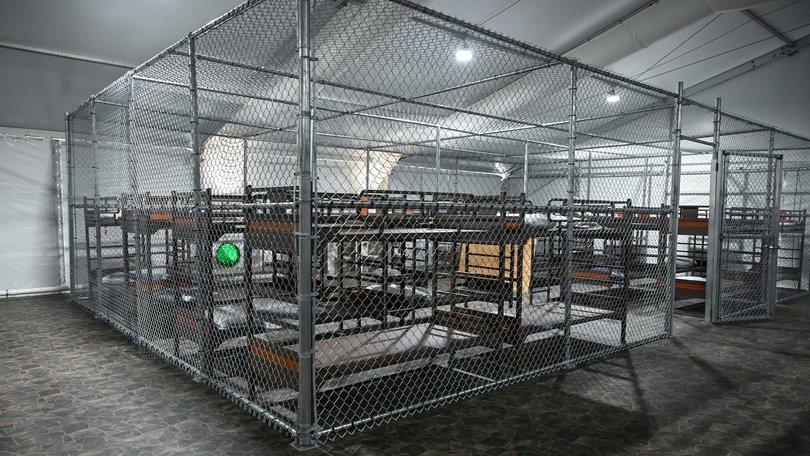THE WASHINGTON POST: Inside ‘Alligator Alcatraz,’ detainees and former guards report horror conditions

Two weeks after it opened, a temporary migrant detention centre in the Florida Everglades is facing expensive logistical challenges: portable toilets routinely back up, sewage needs to be collected and trucked out, and swarms of mosquitoes attack detainees and staff alike.
Without permanent structures, electricity or running water, drinking and bathing water has to be brought in several times a day but is still in short supply, and rainwater leaks into the tents that protect detainees’ chain-link cells, according to interviews with three former guards and phone interviews with detainees.
Their accounts offer details of conditions inside the $US450 million detention centre, which has become a symbol for the Trump administration’s aggressive immigration enforcement policies and been dubbed ‘Alligator Alcatraz’ by Republicans. Five other states are considering using the site as a model, said Homeland Security Secretary Kristi L. Noem, as Immigration and Customs Enforcement prepares to double the nation’s immigrant detention capacity to 100,000 beds.
Sign up to The Nightly's newsletters.
Get the first look at the digital newspaper, curated daily stories and breaking headlines delivered to your inbox.
By continuing you agree to our Terms and Privacy Policy.The location and the makeshift construction of the centre has prompted an outcry from Democrats, environmental activists, local tribal leaders and immigration attorneys, who say it is inhumane and costly.
State officials, who have not permitted independent inspections of the camp requested by lawmakers, dispute the claims.
“The plumbing and sewage claims are false. The facility is in good working order, and detainees have access to drinking water, showers, and clean facilities for hygiene,” Stephanie Hartman, deputy director of communications for the Florida Division of Emergency Management, said.
Three former guards at the facility said they were attracted to the job because of its pay - online ads and a hiring document reviewed by The Washington Post show they were offered $US26 ($40) an hour plus generous overtime: $US39 ($60) an hour.
The Post is not identifying them, as they cited fears of retribution or having signed nondisclosure agreements.
Two of the guards said they were hired by Critical Response Strategies, a Jacksonville, Florida-based consulting company, to work on a rotation of between 21 to 28 days, with seven to 14 days off in between, according to one hiring agreement reviewed by The Post.
Prison guards in Florida typically earn about $US22 ($33) an hour, according to the State’s Department of Corrections.
One former guard said she left her job at another South Florida correctional facility because the pay at Alligator Alcatraz was so enticing. She quit after about a week because she grew upset about the conditions for staff and detainees.
Both of the former guards hired by CRS said they were asked to begin working the same day they applied online. CRS did not return a request for comment.
CRS has a $78 million contract to help manage the facility, including providing a warden, camp manager and correction officers, according to Florida’s contract website.

Staff members are issued a can of mosquito repellent their first day of work, but detainees are sprayed only when they arrive, according to the three former contractors hired as detention guards.
“The mosquitoes are filling the bathrooms, the showers. You go in the shower, you shower with a million mosquitoes. They give you bug spray, but that still doesn’t help,” said a retired South Florida county jail officer who worked as a contracted guard for nearly two weeks before she was fired by her CRS supervisor for reasons she said were not explained to her.
She spoke on the condition of anonymity due to fear of retribution by state officials and supporters of President Donald Trump’s immigration policies.
In phone interviews facilitated by family members and their attorneys, detainees described the mosquitoes in the South Florida wetlands as relentless.
“Most of us have skin irritations from mosquitoes; they don’t give us spray. All of us worry that we’ll get a disease because of the mosquitoes,” said Anderson Miranda, 25, who came to the United States from Guatemala when he was 16 years old. “The mosquitoes don’t let you sleep,” said Juan Javier Gonzalez, 49, who migrated from the Dominican Republic.
Florida Governor Ron DeSantis used emergency powers to seize a little-used airfield in the Big Cypress National Preserve next to Everglades National Park to build what he said is a “makeshift detention space” to house people arrested by ICE agents.

The State spent eight days erecting the site: tents to house detainees, sleeping pods for guards and generators to power the camp, which state officials have said will cost $450 million a year to run.
The detention camp has been enthusiastically endorsed by Trump and other Republicans who point to the natural surroundings - namely alligators - as deterrents to escape.
Asked about the concerns raised by detainees and former guards, the state defended conditions at the Everglades detention centre, saying detainees have access to potable water and that full-size showers are available daily without restrictions.
“Each individual is issued a personal cup they can refill at any time, and bottled water is provided at meals,” Ms Hartman said. “Tanks are regularly sanitised, flushed, and tested to ensure water quality.”
There have been no heat-related or life-threatening incidents, Ms Hartman said, adding that detainees have access to phone and video calls with their attorneys.
The centre has a workforce of more than 1000 people, state officials say, including workers drawn from ICE and the Florida National Guard, as well guards hired by private contractors. The State and the Department of Homeland Security have refused to say how many detainees are housed there; lawmakers who toured the site Saturday said they were told it was more than 750.
Florida Republicans who visited the facility described it as clean and well run. Several noted that they tested the beds and found them comfortable.
“What I saw was a pretty typical footprint in the emergency management disaster space,” State Senator Jay Collins said . “These are well-built, well-developed tents that are put down in a very safe manner. There’s plenty of logistics. I saw backup generators. I saw a supply structure in depth and breadth. As you stepped into the facilities, they were incredibly clean, well maintained.”
But Democrats who took the tour said they experienced a “staged, sanitised” version of the camp that left them still concerned about the welfare of detainees.
They were dressed in orange jumpsuits with some shackled to a bench, some lawmakers said.
Each wore wristbands indicating what kind of offence they allegedly committed - red for a violent offence. They were “crammed in like sardines” into cages with more than 30 other detainees, Democrat Debbie Wasserman Schultz said
After more than two hours, the lawmakers were hustled off the grounds once it appeared there would be rain, several of them said. Some lawmakers asked to stay so they could see if there would be flooding but were told to leave, state Democrat Angie Nixon said.
Some of the detention camp’s “soft-sided” tents started to flood during a visit by Mr Trump, according to videos shot by local media.
Lawmakers should be allowed to return for unannounced visits, Ms Nixon said. “What we saw wasn’t the day-to-day reality,” she said. “But we did see a huge waste of taxpayer dollars.”
They told us about alligators and Florida panthers and venomous snakes and different types of creatures, she said. And if we walk at night, they said just have a buddy with us just in case.
Ms Nixon and four fellow State lawmakers who were denied entrance to independently inspect the facility have sued to gain access to the site.
The Trump administration is increasingly relying on soft-sided facilities, like the ones used in the Everglades facility, for immigrant detention, including tents that have housed migrants in Cuba’s Guantánamo Bay and on the premises of Miami’s overcrowded Krome detention centre.
Despite being less permanent than brick-and-mortar detention centres, these facilities tend to be more expensive because of the costs to quickly assemble, staff and insure them against a higher likelihood of possible risks, said Jason Houser, who was ICE chief of staff from 2021 to 2023.
Florida authorities have said Alligator Alcatraz could house about 3000 migrants this year, at a cost of about $411 ($633) per bed a day. By contrast, ICE said last year that detention beds cost an average of $157.20 ($242) per day.
Staff are housed in small portable units that one former guard described as a “five-by-five cubicle” with a bunk bed. The walk to the latrine was long and terrifying, said one of the guards, who did not sign a nondisclosure agreement but also spoke on the condition of anonymity due to fear of retaliation.

“They told us about alligators and Florida panthers and venomous snakes and different types of creatures,” she said. “And if we walk at night, they said just have a buddy with us just in case.”
She and other former guards said the port-a-potties for staff have backed up, the prepared food is generally cold and they were required to stand for the entirety of their 12-hour shifts, save for a sole 15-minute meal break.
Conditions have also been grim for some detainees, according to guards, detainees and their relatives, who have talked to them by phone and described water pooling on the floors, meals of cold ham sandwiches and lack of hygiene basics such as deodorant, toothbrushes and toothpaste.
The air conditioning stops working sometimes in the middle of the day, and the portable communal toilets in the caged cells have backed up on occasion, causing an unbearable stench, the former guards said.
To pass the time, detainees have created a soccer ball out of a towel or crafted dominoes out of pieces of cardboard cut from lunch boxes, according to a former guard and an immigration attorney. A recreation yard made up of AstroTurf placed over concrete under a tent is also available.
“They’re laying down all day,” one former guard said of the detainees. Some detainees were sick, but staffers were told not to wear masks “because it was going to cause a frenzy” about the possibility of the spread of sicknesses, she said.
One detainee said he went four days without a shower, according to a call recorded by the wife of another Cuban-born detainee, who spoke on the condition of anonymity due to fear of retribution, that was shared with The Post. Another reported being taken to shower facilities only to find no running water. The conditions are worse than the county jails they were transferred from, some said.
Facing questions about conditions at the facility this week, Mr DeSantis defended the detention center, which he has taken to calling “Alligator.”
The State has paused plans to set up more detention centres until “Alligator Alcatraz is filled up,” DeSantis said during a news conference Wednesday. “I’d rather just channel everyone to Alligator.”
“We’re not doing this just to let people have food and shelter, although they do get that. All the minimum standards are upheld,” he said. “But the reality is it’s there to be a quick processing centre, we have a runway right there. They can just be flown back to their home country.”
